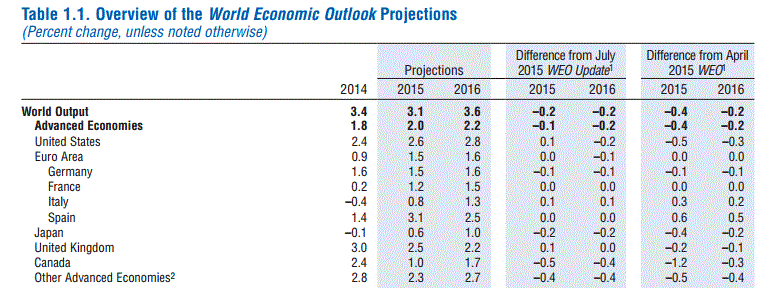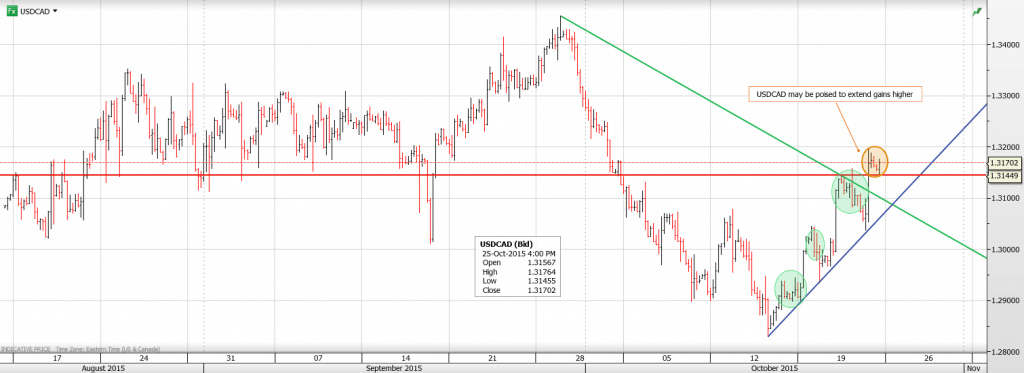When in doubt, devalue. That seems to be the underlying theme behind actual and expected Central Bank actions last week and it looks to be the key theme this week and into year end. Mario Draghi, president of the European Central Bank (ECB) essentially pre-announced that eurozone stimulus will be expanded in December. He expressed concern about risks to eurozone growth because of developments in emerging markets.
The very next day, the Peoples Bank of China (PBoC) cut its benchmark interest rate by 25 bps (the 6th rate cut this year) and chopped the Reserve Requirement Ratio (RRR) by 50 bps.
This Thursday, the Reserve Bank of New Zealand could chop rates for the fourth consecutive time. It is not the consensus forecast at all, but maybe China’s actions changed the dynamics.
Friday, the Bank of Japan (BoJ) may announce additional stimulus measures although most analysts do not think it will happen.
Newton’s Third Law states that “for every action there is an equal and opposite reaction”. The Foreign Exchange Third Law (if there was one) would be that “for every perception of Central Bank action the currency will react. That law was on full display last week. EURUSD sank and USDJPY soared.
Global growth outlook not very rosy
The International Monetary Fund (IMF) downgraded their outlook for global growth again in October and warned that the downside risks to their forecast were more pronounced than they were a few months ago.They could be right. Last Monday, China reported that Q3 economic growth was 6.9%, and below the official 7% target. China’s Premier, Li Keqiang denied that 7% was the official target in comments this weekend, according to Reuters. Apparently 7% really means 6-7%. Perhaps China’s economy is in worse shape than what the data shows.
Chart: IMF Global outlook projections
No man is an island and neither is the Loonie
The Bank of Canada (BoC) can only do so much in influencing the value of the Canadian dollar. Sure they can raise or lower rates whenever they want, but that doesn’t always work. Take New Zealand, the RBNZ has cut interest rates three times in a row since June and they could do it again on Thursday yet traders don’t seem to care. NZDUSD has rallied over .0650 points in just over a month although it still remains the worst performing G-7 currency, year-to-date. (YTD)
The Loonie is the second worst performing currency, YTD, and unlike NZDUSD the two Bank of Canada rate cuts this year didn’t result in Canadian dollar demand. In fact, the currency has not recovered from the moves. The Loonie truly marches to the beat of a different drummer and for the most part this drummer waves the Stars and Stripes while wading in oil.
A Loonie version of the seven fates
The Seven Fates of Canadian dollar direction are:
- BoC policies and interest rate direction
- Federal government fiscal policies
- US and Canadian growth expectations
- CAD/US interest rate differentials
- Commodity prices, particularly oil
- Eurozone issues and ECB stimulus
- China growth concerns
- The Loonie and the BoC
The Bank of Canada’s view of the domestic economy mirrors that of the IMF global outlook. The BoC downgraded their growth and inflation forecasts for 2016. Although the BoC outlook is neutral the combination of their economic downgrades and those of the IMF suggests that Canadian interest rates will remain unchanged with a negative bias. – Bullish USDCAD
- The Loonie and Federal government
The new Liberal government promised massive infrastructure spending. This financial stimulus should help create jobs and increase corporate investment. However, those initiatives may not be seen until much later in 2016. – Neutral USDCAD
- The Loonie and US and Canada growth outlooks
Canadian economic growth may outpace that of its neighbour to the south, even after the BoC’s downgrades. The US economy is expected to grow at 2.3% with an upside bias while the Canadian economy is forecast to grow at an average rate of 2.83%. Traditionally a strong and growing US economy is beneficial to Canada. –Bearish USDCAD
- The Loonie and CAD/US interest rate differentials
Janet Yellen, Chair of the Board of Governors of the Federal Reserve, has not publicly deviated from her opinion that US rates will be rising in 2015. Conversely, the BoC has indicated that Canadian rates won’t be going anywhere for the rest of this year and definitely not up. The widening of the US and Canadian interest rate differential will undermine the Canadian dollar. –Bullish USDCAD
- The Loonie and oil
In addition to the BoC’s two interest rate cuts, the plunge in oil prices also caused the Canadian dollar to plunge. USDCAD has taken turns tracking and ignoring oil price movements, although for the most part, oil price declines mean USDCAD gains and vice versa. At the moment, WTI prices are in a steady downtrend with a break of support at $43.00/barrel targeting a steeper drop to $40.00/b. The US Energy Information Administration (EIA) report on Oct.21, showed a rise in crude stocks of 8.0 million barrels providing further evidence that the global glut has yet to diminish and raising the prospect of lower prices ahead.-Bullish USDCAD
Chart: EIA Change in crude inventory
Source: estimize.com
- The Loonie and the ECB
EURUSD dropped like conservatives on election night when Mario Draghi essentially pre-announced additional stimulus measures will be implemented in December. EURUSD broke major support at 1.1075 with a move the 1.0920-40 area targeting further weakness to 1.0775. However, at the moment, the EURCAD technicals do not support this move. It may just be a matter of time before EURCAD breaks below 1.4350-75 and if it does, the Canadian dollar should get a bit of support from sales of EURCAD.
Unfortunately, if EURUSD is heading south, USDCAD will likely be heading north meaning a doveish ECB is bad for the Canadian dollar. –Bullish USDCAD
- The Loonie and China
China’s voracious appetite for commodities and oil provided a huge amount of support to the Canadian dollar. But that time is past. China is still growing but not as fast as before and their demand for commodities has diminished. If the Chinese economy continues to falter (and now China is apparently happy with 6% growth) it will continue to have a negative impact on the commodity bloc. –Bullish USDCAD
USDCAD technical outlook
The short term USDCAD technicals are bullish with the uptrend from the October 15 low intact while trading above 1.3090. A break above minor resistance in the 1.3190-1.3210 area would extend gains to 1.3280 and then 1.3450. A long term downtrend from the all-time high at 1.6170 in 2002 comes into play in the 1.3460-1.3500 area on a weekly chart. This is also the 61.8% Fibonacci retracement level of the 2002-2007 range which suggests further gains above this area should be difficult. A move below 1.3090 suggests further 1.2900-1.3200 consolidation.
Chart: USDCAD 4 hour noting bullish set up ; Source Saxo Bank
Money may be easy and the Loonie may still be cheap
The central bank interest rate race to zero and beyond is still on the back stretch and although the BoC is a willing participant it is already showing signs of coming up lame. The US economy is rebounding and although there will be a lag, the benefits of the rebound will start flowing into Canada. The steep drop in WTI prices that have depressed the Canadian dollar appear to have found a floor just above $37.00/b which if it holds, will limit additional Canadian dollar losses. USDCAD may continue to move higher in the next few weeks but the magnitude of the gains will be smaller as a lot of the bad news is reflected in the price. The Loonie may be cheap but not as cheap as it once was.
By David Marks FX Strategist , Agility Forex











